A client created a new KPI: CPS (Cost per Sign-up).
The new KIP is mapped within the data stream mapping, and is populated with the following logic: (Media Cost) / Sign-ups)
As can be seen in the table below, CPS was created twice and was set with two different aggregations:

From looking at the table, what are the aggregation settings for each one of the newly created KPIs?
A)

B)

C)

D)

A client's data consists of three data streams as follows:
Data Stream A:
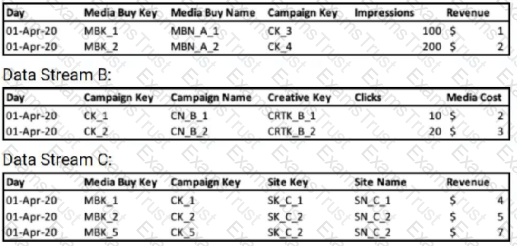
The data streams should be linked together through a parent-child relationship.
Out of the three data streams, Data Stream C is considered the source of truth for both the dimensions and measurements.
The client would like to have a "Site Revenue" measurement.
This measurement should return the highest revenue value per Site, for example:
For Site Key ‘SK_C_2’, the "Site Revenue" should be $7.00.
When aggregated by date, the "Site Revenue" measurement should return the total sum of the results of all sites.
For example:
For the date 1 Apr 2020, "Site Revenue" should be $11.00 (sum of Site Revenue for Site Keys ‘SK_C_1' ($4.00) and ‘SK_C_2’ ($7.00))
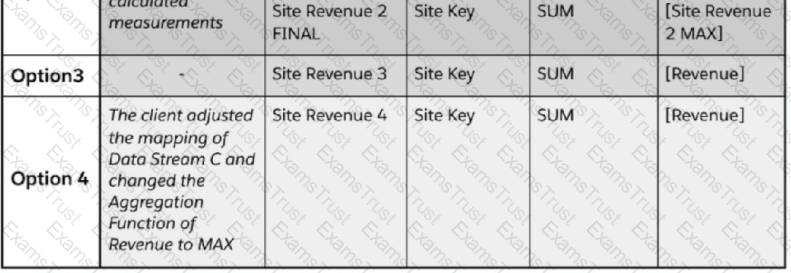
Which options will yield the desired result;
A client has integrated data from Facebook Ads. Twitter ads, and Google ads in marketing Cloud intelligence. For each data source, the source, the data follows a naming convensions as …
Facebook Ads Naming Convention - Campaign Name:
CampID_CampName#Market_Object#object#targetAge_TargetGender
Twitter Ads Naming Convention- Media Buy Name
MarketTargeAgeObjectiveOrderID
Google ads Naming Convention-Media Buy Name:
Buying_type_Market_Objective
The client wants to harmonize their data on the common fields between these two platforms (i.e. Market and Objective) using the Harmonization Center. Given the above information, which statement is correct regarding the ability to implement this request?
wet Me - Given the above information, which statement i 's Correct regarding the ability to implement this request?
An implementation engineer has been asked to perform QA for a standard file ingestion, done by the client.
The source file that was ingested can be seen below:

The number of rows added to this data stream is 3. What could have led to this discrepancy?
Which Marketing Cloud Intelligence field is considered an attribute and not a “variable”?
A client provides the following three files:
File A:

File B:

File C:

File A was uploaded using the Ads data stream type.
The client would like to create this view (data from Files B & C) in Datorama:

Which proposed solution would cause a false connection between the two files?
A technical architect is provided with the logic and Opportunity file shown below:
The opportunity status logic is as follows:
For the opportunity stages “Interest”, “Confirmed Interest” and “Registered”, the status should be “Open”.
For the opportunity stage “Closed”, the opportunity status should be closed.
Otherwise, return null for the opportunity status.
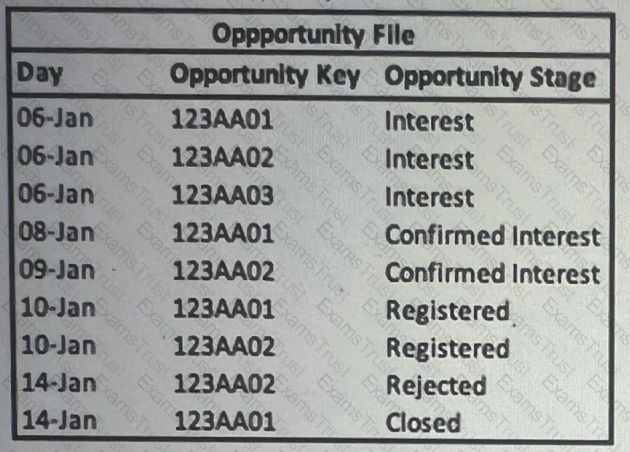
Given the above file and logic and assuming that the file is mapped in a GENERIC data stream type with the following mapping:
“Day” — Standard “Day” field
“Opportunity Key” > Main Generic Entity Key
“Opportunity Stage” — Generic Entity key 2
A pivot table was created to present the count of opportunities in each stage. The pivot table is filtered on Jan 7th -11th.Which option reflects the stage(s) the opportunity key 123AA01 is associated with?
A client's data consists of three data streams as follows:
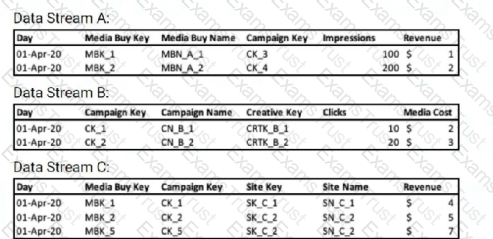
* The data streams should be linked together through a parent-child relationship.
* Out of the three data streams, Data Stream C is considered the source of truth for both the dimensions and measurements.
Which data stream should be set as a parent?
A technical architect is provided with the logic and Opportunity file shown below:
The opportunity status logic is as follows:
For the opportunity stages “Interest”, “Confirmed Interest” and “Registered”, the status should be “Open”.
For the opportunity stage “Closed”, the opportunity status should be closed
Otherwise, return null for the opportunity status
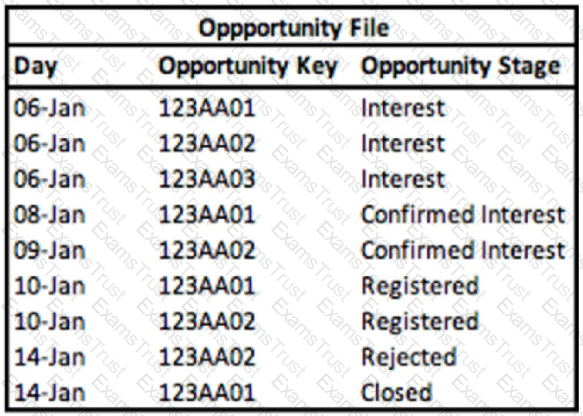
Given the above file and logic and assuming that the file is mapped in a GENERIC data stream type with the following mapping:
“Day” — Standard “Day” field
“Opportunity Key” > Main Generic Entity Key
“Opportunity Stage” — Main Generic Entity Attribute
“Opportunity Count” — Generic Custom Metric
A pivot table was created to present the count of opportunities in each stage. The pivot table is filtered on Jan 11th. What is the number of opportunities in the Interest stage?
A technical architect is provided with the logic and Opportunity file shown below:
The opportunity status logic is as follows:
For the opportunity stages “Interest”, “Confirmed Interest” and “Registered”, the status should be “Open”.
For the opportunity stage “Closed”, the opportunity status should be closed.
Otherwise, return null for the opportunity status.
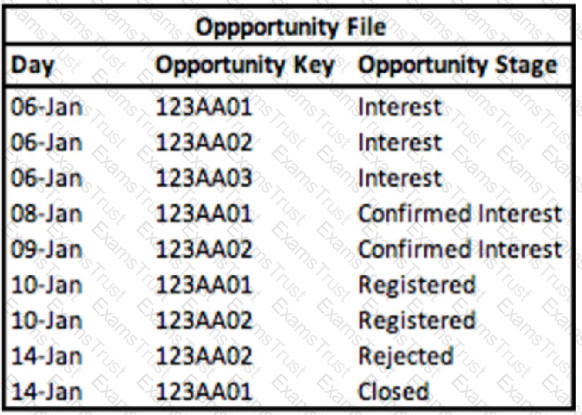
Given the above file and logic and assuming that the file is mapped in a GENERIC data stream type with the following mapping:
“Day” — Standard “Day” field
“Opportunity Key” > Main Generic Entity Key
“Opportunity Stage” — Generic Entity Key 2
“Opportunity Count” — Generic Custom Metric
A pivot table was created to present the count of opportunities in each stage. The pivot table is filtered on Jan 7th - 10th. How many different stages are presented in the table?
Your client provided the following sources:
Source 1:
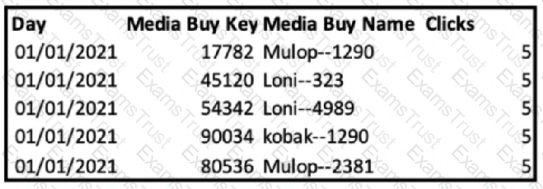
Source 2:
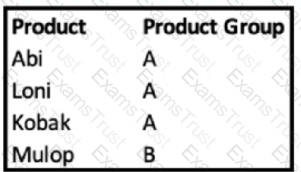
Source 3:
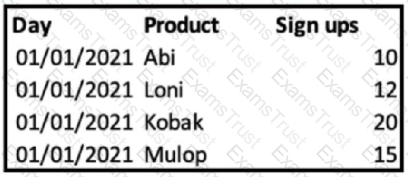
As can be seen, the Product values present in sources 2 and 3 are similar and can be linked with the first extraction from ‘Media Buy Name’ in source1
The end goal is to achieve a final view of Product Group alongside Clicks and Sign Ups, as described below:

Which two options will meet the client’s requirement and enable the desired view?
Your client has provided sample files of their data from the following data sources:
Google Campaign Manager

Below are the requirements from the client and additional information:
* The sources are linked to each other by shared Media Buy names.
* In addition to the mutual Media Buys, the sources contain campaign and site values. However, the client would like to see the campaign/site values coming from Google CM and not from Google DV360.
* The source of truth for cost is Google DV360
Which action(s) are needed to take place in order to meet the client’s requirement and set Google DV360 as the source of truth for Cost?
A client has integrated the following files:
File A:

File B:

The client would like to link the two files in order to view the two KPIs (‘Tasks Completed’ and ‘Tasks Assigned) alongside ‘Employee Name’ and/or
‘Squad’.
The client set the following properties:
+ File A is set as the Parent data stream
* Both files were uploaded to a generic data stream type.
* Override Media Buy Hierarchies is checked for file A.
* The ‘Data Updates Permissions’ set for file B is ‘Update Attributes and Hierarchy’.
When filtering on the entire date range (1-30/8), and querying employee ID, Name and Squad with the two measurements - what will the result look like?
A)

B)

C)

D)

Client has provided sample flies of their data from the following data sources:
Google Campaign Manager

Below are the requirements from the client and additional information:
• The sources are linked to each other by shared Media Buy names.
• In addition-to the mutual Media Buys, the sources contain campaign and site values. However, the client would like to see the campaign/site values coming from Google CM and not from Google DV360.
• The source of truth for cost is Google DV360.
As a first step, a Parent-Child relationship was created between the two files, and the following mapping was performed, within both data streams:
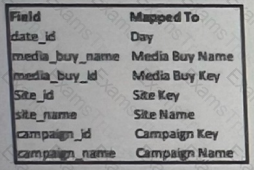
Please note:
• All other measurements were mapped as well to the appropriate fields.
• No other mapping manipulations or formulas were implemented.
How many records will the merged table hold?
A client Ingested the following We into Marketing Cloud Intelligence:

The mapping of the above file can be seen below:
Date — Day
Media Buy Key — Media Buy Key
Campaign Name — Campaign Name
Campaign Group -. Campaign Custom Attribute 01
Clicks —> Clicks
Media Cost —> Media Cost
Campaign Planned Clicks —> Delivery Custom Metric 01
The client would like to have a "Campaign Planned Clicks" measurement.
This measurement should return the "Campaign Planned Clicks" value per Campaign, for example:
For Campaign Name 'Campaign AAA", the "Campaign Planned Clicks" should be 2000, rather than 6000 (the total sum by the number of Media Buy keys).
In order to create this measurement, the client considered multiple approaches. Please review the different approaches and answer the following question:
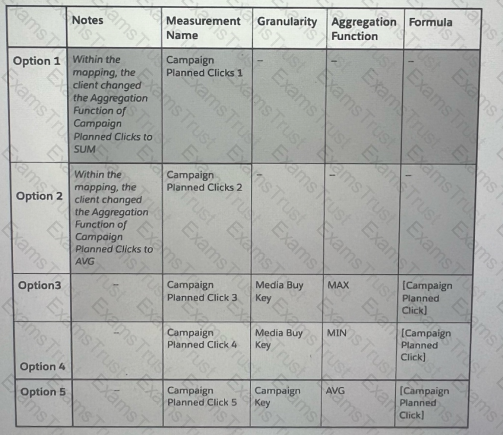
Which two options will yield a false result:
A client’s data consists of three data streams as follows:
Data Stream A:
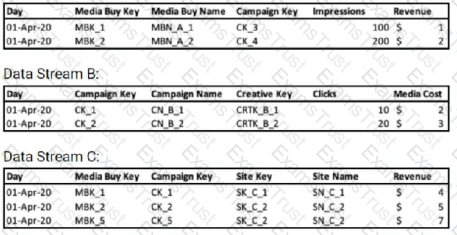
* The data streams should be linked together through a parent-child relationship.
* Out of the three data streams, Data Stream C is considered the source of truth for both the dimensions and measurements.
Assuming the data was ingested properly and the Parent Child was created correctly according to the client's requirements, what is the total
Impressions value for Campaign Key ‘CK_3’?
Which two statements are correct regarding the Parent-Child configuration?
A client's data consists of three data streams as follows:
Data Stream A:
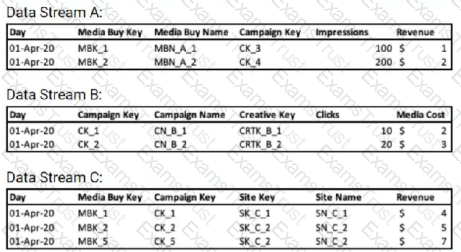
* The data streams should be linked together through a parent-child relationship.
* Out of the three data streams, Data Stream C is considered the source of truth for both the dimensions and measurements.
* Data Stream C was set as a ‘Parent’, and the ‘Override Media Buy Hierarchy’ checkbox is checked
What should the Data Updates Permissions be set to for Data Stream B?